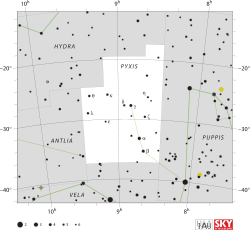Gamma Pyxidis

|
| Observation data Epoch J2000 Equinox J2000 | |
|---|---|
| Constellation | Pyxis |
| Right ascension | 08h 50m 31.9233s[1] |
| Declination | −27° 42′ 35.440″[1] |
| Apparent magnitude (V) | 4.026[2] |
| Characteristics | |
| Spectral type | K3III[2] |
| U−B color index | +1.368[3] |
| B−V color index | +1.284[3] |
| Astrometry | |
| Radial velocity (Rv) | 24.5 km/s |
| Proper motion (μ) | RA: −133.49[1] mas/yr Dec.: 88.16[1] mas/yr |
| Parallax (π) | 15.63 ± 0.58[1] mas |
| Distance | 209 ± 8 ly (64 ± 2 pc) |
| Details | |
| Luminosity | 178[4] L☉ |
| Surface gravity (log g) | 2.35[5] cgs |
| Temperature | 4,270[5] K |
| Metallicity [Fe/H] | -0.05[5] dex |
| Other designations | |
Gamma Pyxidis (Gamma Pyx, γ Pyxidis, γ Pyx) is a 4th magnitude star in the constellation Pyxis. It is classified as a giant star of composition similar to the Sun[6] and is located an estimated 209 light years[1] from the Solar System.
Gamma Pyxidis is moving through the Galaxy at a speed of 54.2 km/s relative to the Sun. Its projected Galactic orbit carries it between 21,300 and 30,700 light years from the center of the Galaxy.[7]
Naming
In Chinese, 天狗 (Tiān Gǒu), meaning Celestial Dog, refers to an asterism consisting of γ Pyxidis, e Velorum, f Velorum, β Pyxidis, α Pyxidis and δ Pyxidis. Consequently, γ Pyxidis itself is known as 天狗六 (Tiān Gǒu liù, English: the Sixth Star of Celestial Dog.)[8]
References
- ↑ 1.0 1.1 1.2 1.3 1.4 1.5 Perryman, M. A. C. et al. (1997), "The Hipparcos Catalogue", Astronomy & Astrophysics 323: L49–L52, Bibcode:1997A&A...323L..49P
- ↑ 2.0 2.1 "gam Pyx", SIMBAD (Centre de Données astronomiques de Strasbourg), retrieved 2009-06-03
- ↑ 3.0 3.1 Gutierrez-Moreno, Adelina; Moreno, Hugo (June 1968), "A photometric investigation of the Scorpio-Centaurus association", Astrophysical Journal Supplement 15: 459, Bibcode:1968ApJS...15..459G, doi:10.1086/190168
- ↑ Mallik, Sushma V. (December 1999), "Lithium abundance and mass", Astronomy and Astrophysics 352: 495–507, Bibcode:1999A&A...352..495M
- ↑ 5.0 5.1 5.2 Cenarro, A. J. et al. (2007), "Medium-resolution Isaac Newton Telescope library of empirical spectra - II. The stellar atmospheric parameters", Monthly Notices of the Royal Astronomical Society 374 (2): 664–690, arXiv:astro-ph/0611618, Bibcode:2007MNRAS.374..664C, doi:10.1111/j.1365-2966.2006.11196.x
- ↑ Keenan, Philip C.; Barnbaum, Cecilia (June 1999), "Revision and Calibration of MK Luminosity Classes for Cool Giants by HIPPARCOS Parallaxes", The Astrophysical Journal 518 (2): 859–865, Bibcode:1999ApJ...518..859K, doi:10.1086/307311
- ↑ Gamma Pyxidis (HIP 43409)
- ↑ (Chinese) AEEA (Activities of Exhibition and Education in Astronomy) 天文教育資訊網 2006 年 7 月 17 日
| ||||||||||||||||||||||||||